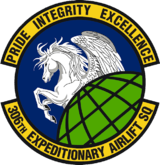306th Expeditionary Airlift Squadron
| 306th Expeditionary Airlift Squadron | |
|---|---|
| Active | 1943-1946; 1949-1951; 2011-2012 |
| Country |
|
| Branch |
|
| Role | Airlift |
| Part of | Air Mobility Command |
| Motto(s) | Pride, Integrity, Excellence |
| Decorations | Distinguished Unit Citation |
| Insignia | |
| 306th Expeditionary Airlift Squadron emblem |
 |
The 306th Expeditionary Airlift Squadron is a provisional United States Air Force unit. It is assigned to Air Mobility Command, and operates from Joint Base Andrews, Maryland.
Mission
Attached to the 89th Airlift Wing at Joint Base Andrews, Maryland, the squadron operates from New Castle Air National Guard Base, Delaware with 60 maintenance personnel, and about a dozen operations personnel supporting five four C-17 Globemaster III aircraft. The squadron supports presidential airlift, through a mission known as "Banner Express". Aircraft and personnel are prepositioned to support an expected surge in airlift requirements.
The squadron was expected to commence operations in April 2012 and inactivate in late November.
History
World War II
The squadron was first activated with Douglas C-47 Skytrains in September 1943 as the 306th Troop Carrier Squadron at Sedalia Army Air Field, Missouri and trained under I Troop Carrier Command. It trained in various parts of the eastern United States until early 1944. The unit then deployed to England, where it became part of IX Troop Carrier Command.
The squadron prepared for the invasion of Nazi-occupied Europe. It began operations by dropping paratroops of the 101st Airborne Division in Normandy on D-Day (6 June 1944) and releasing gliders with reinforcements on the following day. The unit received a Distinguished Unit Citation and a French citation for these missions. After the Normandy invasion the squadron ferried supplies in the United Kingdom.
After moving to France in September, the unit dropped paratroops of the 82nd Airborne Division near Nijmegen and towed gliders carrying reinforcements during Operation Market Garden, the airborne attack on the Netherlands. In December, it participated in the Battle of the Bulge by releasing gliders with supplies for the 101st Airborne Division near Bastogne.
When the Allies made the air assault across the Rhine River in March 1945, each aircraft towed two gliders with troops of the 17th Airborne Division and released them near Wesel. The squadron also hauled food, clothing, medicine, gasoline, ordnance equipment, and other supplies to the front lines and evacuated patients to rear zone hospitals. It converted from C-47s to Curtiss C-46 Commandos and used the new aircraft to transport displaced persons from Germany to France and Belgium after V-E Day. It was inactivated in Germany in September 1946.
Air Force reserve operations
Postwar, the squadron was activated in the Air Force reserve in 1949 at Fairfax Field, Kansas. At Fairfax, it again operated C-46 Commandos. The squadron was called to active duty during the Korean War in 1951, and its aircraft and personnel were used as fillers other units and the squadron was inactivated.
Operations and decorations
- Combat Operations. The unit participated in airborne assaults on Normandy during Operation Neptune in June 1944; in Southern France during Operation Dragoon; over the Netherlands during Operation Market in September 1944; and in Germany during Operation Varsity in March 1945.
- Campaigns. World War II: Rome-Arno; Southern France; Normandy; Northern France; Rhineland; Central Europe.
- Decorations. Distinguished Unit Citation: France, [6-7] Jun 1944
Lineage
- Constituted as the 306th Troop Carrier Squadron on 25 May 1943
- Activated on 1 September 1943
- Inactivated on 30 September 1946
- Redesignated 306th Troop Carrier Squadron, Medium on 10 May 1949
- Activated in the reserve on 27 June 1949
- Ordered to active service on 10 March 1951
- Inactivated on 12 March 1951
- Redesignated 306th Expeditionary Airlift Squadron and converted to provisional status on 27 March 2003.
Assignments
- 442d Troop Carrier Group, 1 September 1943 - 30 September 1946
- 442d Troop Carrier Group, 27 June 1949 - 12 March 1951
- Air Mobility Command to activate or inactivate at any time after 27 March 2003.
- Attached to 89th Airlift Wing, 1 December 2011 - c. November 2012
Stations
|
|
Aircraft
- Douglas C-47 Skytrain, 1943-1946; 1949-1950
- Waco CG-4A Glider, 1944-1945
- Curtiss C-46|C/TC-46 Commando, 1949, 1950-1951
- C-17 Globemaster III, 2012
See also
References
Notes
Bibliography
![]() This article incorporates public domain material from the Air Force Historical Research Agency website http://www.afhra.af.mil/.
This article incorporates public domain material from the Air Force Historical Research Agency website http://www.afhra.af.mil/.
- Maurer, Maurer, ed. (1982) [1969]. Combat Squadrons of the Air Force, World War II (PDF) (reprint ed.). Washington, DC: Office of Air Force History. ISBN 0-405-12194-6. LCCN 70605402. OCLC 72556.
.svg.png)
